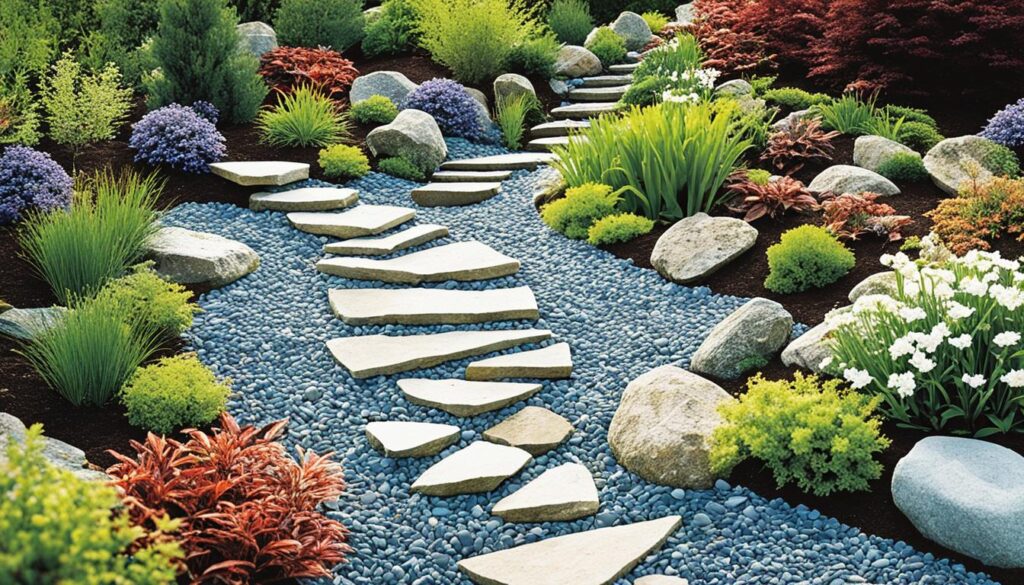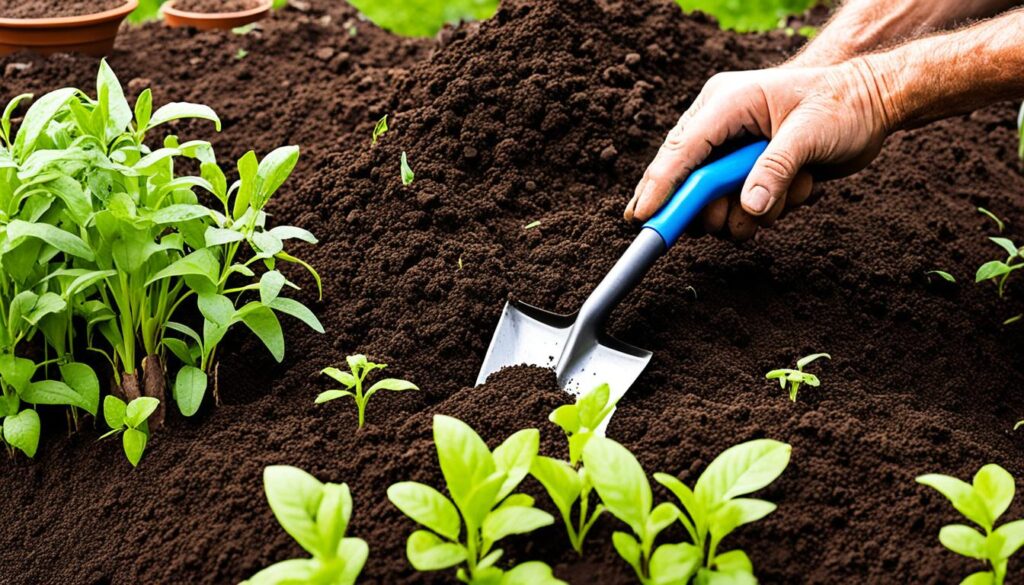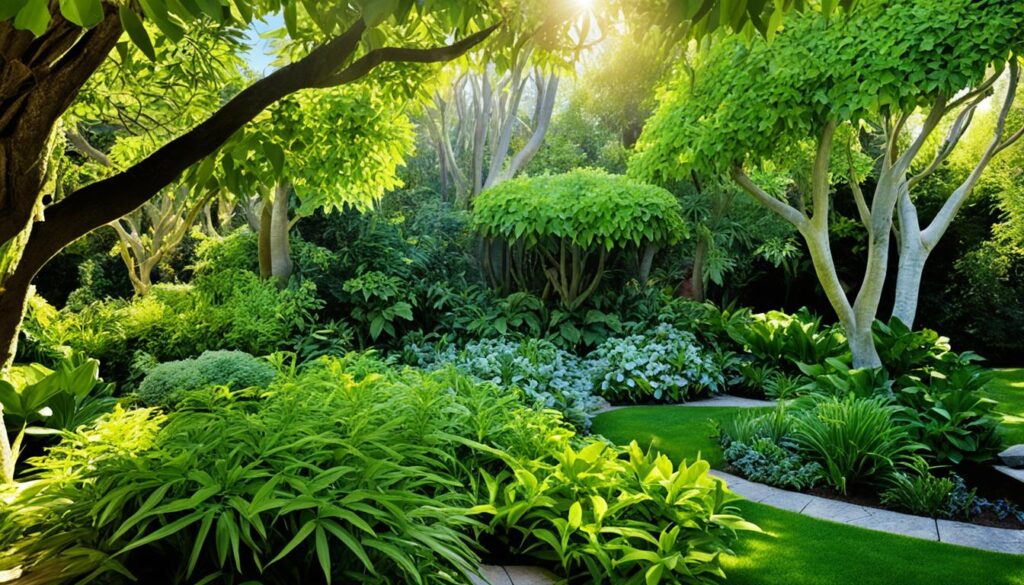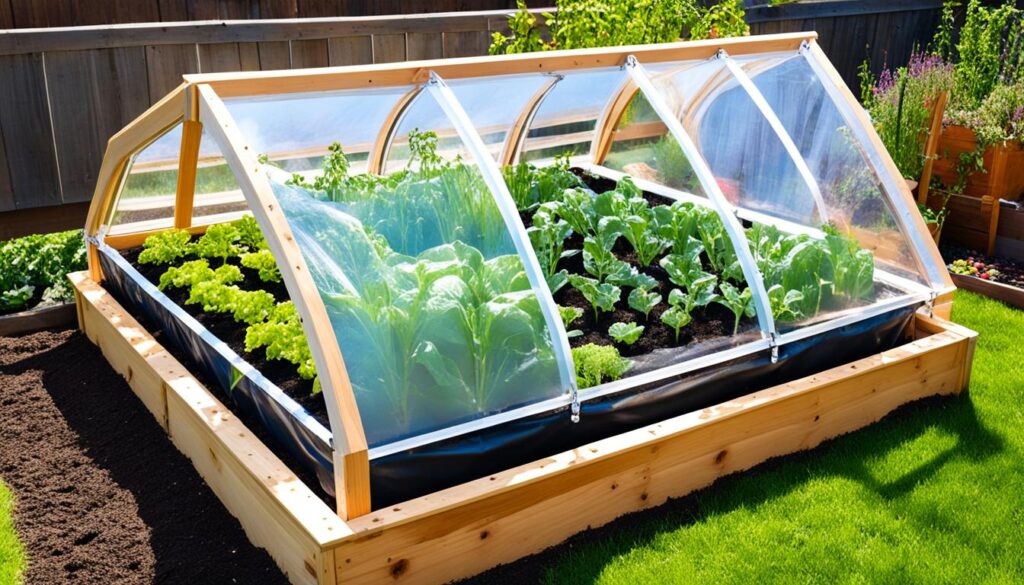Welcome to my guide on how to make a stunning dish garden! Whether you’re an experienced plant enthusiast or a beginner with a green thumb, I’ll walk you through the process of creating your very own indoor oasis. With these dish gardening tips and step-by-step instructions, you’ll be able to design and assemble a beautiful arrangement of plants that will add life and vibrancy to any space in your home.
Key Takeaways:
- Create your own dish garden to bring beauty and tranquility to your indoor space.
- Choose the perfect container that matches your style and complements your home decor.
- Select low-maintenance plants like succulents and small ferns that thrive in indoor environments.
- Prepare the container by cleaning it and adding a layer of stones for proper drainage.
- Arrange and plant the selected plants with consideration for their sizes, colors, and textures.
Choosing the Perfect Container
The first step in making a dish garden is selecting the right container. Choose a shallow dish or container with drainage holes to prevent waterlogging. Consider the size and shape of the container based on the number and types of plants you want to include. Also, think about the overall aesthetic appeal of the dish garden and how it will fit into your home decor.
When selecting a container for your dish garden, it’s important to choose one that allows excess water to drain properly. This helps prevent overwatering and root rot, which can be detrimental to the health of your plants. Look for containers with drainage holes or opt for non-traditional options like terrariums with an open top or decorative trays with raised sides.
Consider the size and shape of the container based on the number and types of plants you want to include. A shallow dish or container provides ample space for the plants’ roots while creating a visually appealing arrangement. Additionally, a shallow container allows for proper air circulation, which helps prevent moisture buildup and the growth of mold or fungi.
When choosing a container, don’t forget to think about the overall aesthetic appeal of the dish garden. Consider the style, colour, and material of the container to ensure it complements your home decor. For a cohesive look, choose a container that matches the theme or style of your interior design. Alternatively, opt for a container that adds a pop of colour or acts as a focal point in the room.
Plant Selection
Keep in mind that the container you choose will dictate the types of plants you can include in your dish garden. Some plants require more space for their roots to grow, while others thrive in smaller containers. Take the time to research the growth habits and care requirements of your desired plants to ensure they are compatible with the selected container.
Now that you have chosen the perfect container for your dish garden, it’s time to move on to the next step: selecting the ideal plants. In the next section, I will guide you through the process of choosing plants that are well-suited for dish gardens.
Selecting the Ideal Plants
When it comes to creating a stunning dish garden, choosing the right plants is key. Opt for low-maintenance varieties that thrive in indoor environments, such as succulents, cacti, and small ferns. These plants are perfect for dish gardens as they can withstand dry conditions and require minimal care.
Succulents, with their fleshy leaves and water-storing abilities, are particularly popular for dish gardens. They come in a wide range of shapes, sizes, and colors, allowing you to create a visually captivating arrangement. Cacti, on the other hand, add a unique and spikey texture to your dish garden. Their ability to survive in arid conditions makes them an ideal choice.
In addition to succulents and cacti, consider incorporating small ferns into your dish garden. Ferns bring a lush and delicate feel to the arrangement with their feathery fronds. They thrive in low-light conditions and add a touch of elegance to your indoor oasis.
When selecting plants, it’s important to choose a variety with different heights, textures, and colors. This diversity adds visual interest and creates a harmonious blend within your dish garden. A mix of upright and trailing plants can add dimension and movement. Experiment with varying leaf shapes and colors to create a visually captivating display.
With the right plant selection, you can create a beautiful dish garden that brings life and greenery to any space. Take some time to research and choose plants that suit your personal style and the conditions in your home. Let your creativity flourish as you design a one-of-a-kind dish garden that will be a focal point in your home.
Preparing the Container
Before planting, it’s important to make sure that your dish or container is clean and residue-free. This will help create a healthy environment for your plants to thrive. Take a moment to inspect the container and give it a gentle scrub if needed.
To aid in proper drainage, start by adding a layer of small stones to the bottom of the container. This will prevent water from pooling and potentially causing root rot. The stones also provide stability to the plants and help maintain good airflow.

Next, add a layer of well-draining potting soil, leaving enough space for the plants to fit comfortably. Use your hands or a trowel to evenly distribute the soil and create a level surface. This high-quality potting soil will provide the necessary nutrients and support for your dish garden plants.
Gently tap the container on a solid surface to settle the soil and eliminate any air pockets. This will ensure that the plants’ roots make good contact with the soil and promote healthy growth.
Now that the container is prepared, you’re ready to move on to the exciting part: arranging and planting your dish garden!
Arranging and Planting
Once you have carefully selected your plants for your dish garden, it’s time to arrange them in a way that brings out their natural beauty. Consider the heights and growth patterns of each plant to create a visually pleasing arrangement. Place taller plants towards the back or center of the container, and shorter plants towards the front or edges.
Take a moment to visualize how the plants will look together, considering their colors, textures, and shapes. Play around with different arrangements until you find one that you love.
When you’re satisfied with the placement of the plants, it’s time to transplant them into the prepared container. Depending on the size of the container and the root systems of the plants, you may need to use a small gardening tool to create holes in the soil.
Make sure to handle the plants gently, taking care not to damage their delicate root systems. Place each plant into its designated hole, making sure to position it at a depth that allows the soil to cover the roots fully. Press the soil down firmly around the roots to ensure they are secure.
As you plant each individual plant, consider how it interacts with the other plants in the arrangement. Aim for a balanced look, with each plant complementing and enhancing the overall design of the dish garden.
Once all the plants are securely planted, take a step back and admire your handiwork. You have successfully arranged and planted your dish garden! This is an exciting moment as you get to see your vision come to life.
Now that your dish garden is complete, it’s time to move on to the next step: caring for your indoor oasis. But before we do that, let’s review the key points of arranging and planting your dish garden.
Caring for Your Dish Garden
To keep your dish garden thriving, it’s important to provide the right care and conditions. Follow these dish gardening tips to ensure your indoor plant arrangement flourishes for years to come.
1. Placement
Place your dish garden in a location with bright, indirect sunlight. This will provide the plants with the necessary light for photosynthesis without exposing them to direct heat or cold drafts. Avoid placing your dish garden near windows that receive direct sunlight, as this can scorch the leaves.
2. Temperature and Humidity
Avoid placing your dish garden in areas with extreme temperature fluctuations, such as near heaters or air conditioning vents. Maintain a moderate room temperature between 65°F and 75°F (18°C and 24°C) to keep the plants comfortable. Additionally, try to provide a humidity level of around 40% to 60%, which is suitable for most indoor plants.
3. Watering
When it comes to watering your dish garden, it’s important to find the right balance. Allow the soil to dry out slightly between waterings, as overwatering can lead to root rot. Use your finger to gently check the moisture level in the soil before watering. If it feels dry up to the first knuckle, it’s time to water. Be sure to water thoroughly, ensuring the water reaches all areas of the container.
4. Dusting and Pruning
Regularly dust the leaves of your dish garden with a soft cloth or sponge to keep them clean and allow for proper photosynthesis. This will also help prevent pests from taking hold. Additionally, remove any dead or decaying foliage to maintain the overall health and appearance of your plants.
By following these dish gardening tips, you’ll be able to provide the necessary care for your indoor plant arrangement. Now, let’s move on to some creative dish garden ideas to inspire your own designs.
Creative Dish Garden Ideas
When it comes to creating a dish garden, there’s no limit to your imagination. Let your creativity flow and add unique elements to make your dish garden truly stand out. Here are some creative ideas to inspire you:
Add Decorative Stones
Decorative stones can bring texture and depth to your dish garden. Choose stones in different sizes and colours to create visual interest. You can arrange them around the plants or create a pathway with stones leading to a focal point in your dish garden.
Include Miniature Figurines
Add a touch of whimsy to your dish garden by incorporating miniature figurines. From tiny fairies to animals, these figurines can create a magical scene within your plant arrangement. Place them strategically among the plants to create a sense of wonder and imagination.
Embrace Small Ornaments
Small ornaments like birdhouses, lanterns, or mini garden tools can add charm to your dish garden. Look for unique and eye-catching ornaments that match your personal style. These small details can make a big difference in the overall design of your dish garden.
Create a Theme or Color Scheme
To bring a cohesive look to your dish garden, consider choosing a theme or color scheme. This will tie the whole arrangement together and create a visually pleasing display. You can opt for a tropical theme with vibrant greens and pops of colourful flowers, or go for a monochromatic scheme with different shades of green and white.
Experiment with Different Containers
Think outside the box and use a variety of containers for your dish garden. Teacups, vintage dishes, or even unexpected items like old watering cans can add a unique touch to your design. Just ensure that your chosen containers have proper drainage to keep your plants healthy.
Remember, the key to a successful dish garden is to let your creativity shine. Have fun experimenting with different elements and designs to create a dish garden that reflects your personal style and brings joy to your space.

Troubleshooting Tips
If you encounter any issues with your dish garden, don’t worry. With a few simple steps, you can overcome common problems and ensure the optimal health of your plants. Here are some troubleshooting tips:
Yellowing Leaves
If you notice yellowing leaves in your dish garden, it could indicate various issues, including overwatering, nutrient deficiencies, or inadequate sunlight. Evaluate the watering schedule and adjust if necessary. Remember, it’s better to underwater than overwater. Check the soil moisture level before every watering. Ensure your dish garden is receiving enough indirect sunlight for the plants to thrive. Consider moving it to a brighter location if needed.
Pests Infestation
Keep an eye out for common pests that can harm your plants, such as aphids or mealybugs. If you spot any signs of pest infestation, take immediate action to prevent the problem from spreading. Isolate affected plants and treat them accordingly. You can try using organic insecticidal soap or neem oil to control and eliminate pests. Regularly inspect your dish garden to catch and address any infestation early on.
Disease Control
Dish gardens are susceptible to various diseases, including fungal infections and root rot. To prevent the spread of diseases, promptly remove any affected plants from the dish garden. Disinfect your tools after each use to minimize the risk of contamination. Ensure proper air circulation by spacing out your plants appropriately. Maintain a consistent watering schedule and avoid waterlogging the plants. If necessary, consult a local garden expert for guidance on disease control.
Regular Inspection
Regularly inspect your dish garden to ensure the plants are healthy and thriving. Look for any signs of wilting, discoloration, or pest activity. Monitor the moisture level of the soil and adjust watering accordingly. Pay attention to the overall appearance and growth of the plants. By being proactive and addressing any issues early on, you can maintain a vibrant and beautiful dish garden.
Enjoying Your Indoor Oasis
Now that you’ve successfully created your dish garden, it’s time to sit back and enjoy the beauty it brings to your home. Your indoor oasis will not only add a touch of greenery but also create a calming and serene atmosphere.
To ensure your plants continue to flourish, it’s essential to keep up with the necessary care and maintenance. Regularly check the moisture level of the soil and water your dish garden accordingly. Remember, each plant has different water requirements, so it’s crucial to observe their individual needs.
Don’t be afraid to experiment with different plant combinations and designs to refresh your dish garden whenever you desire. This allows you to showcase your creativity and personal style while adding an element of surprise to your indoor space. Whether you opt for a minimalistic arrangement or a vibrant mix of colors and textures, the possibilities are endless.
So, take a moment to appreciate the tranquility and natural beauty of your dish garden. With proper care, it will continue to thrive and bring joy to your home for years to come. Allow it to be a reminder of the wonders of nature and a refuge of calmness in your everyday life.








